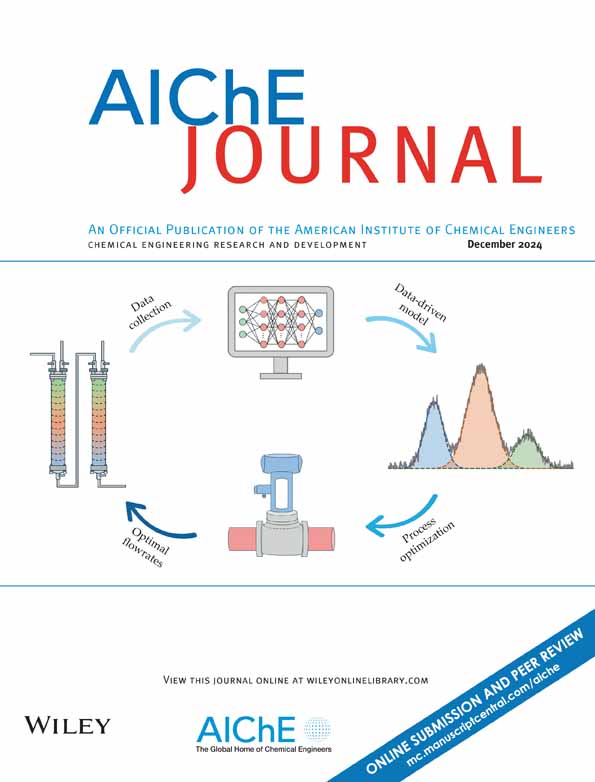Balancing acetylene and hydrogen chloride adsorption through gold-copper-nickel synergistic interactions for enhanced acetylene hydrochlorination
IF 3.5
3区 工程技术
Q2 ENGINEERING, CHEMICAL
引用次数: 0
Abstract
Metal promoters enhancing Au catalysts present a promising alternative to toxic mercury chloride. However, achieving an optimal balance between the synergistic benefits of metal promoters and challenges like coke formation remains a significant hurdle. Herein, a low-loading Au catalyst (0.15 wt.%), synergistically modulated by copper and nickel (designated as AuCu16Ni/AC), was developed. The AuCu16Ni/AC catalyst exhibits a dynamic restructuring mechanism and synergistic effects, enabling balanced adsorption of acetylene (C2H2) and hydrogen chloride. This enhances catalytic efficiency, effectively suppresses coke formation, and significantly improves catalyst stability. As a result, the AuCu16Ni/AC catalyst achieves outstanding performance, with a high C2H2 conversion rate of 93.03% under C2H2 gas hourly space velocity conditions of 540 h−1 and a remarkably low deactivation rate of 0.12% h−1. This work provides a low-loading, highly stable catalyst with promising industrial applicability while offering novel insights and a theoretical basis for the design of multi-component catalysts.通过金-铜-镍协同作用平衡乙炔和氯化氢的吸附,增强乙炔的加氢氯化作用
金属促进剂增强金催化剂是一种有前途的替代有毒的氯化汞。然而,在金属促进剂的协同效益和焦炭形成等挑战之间实现最佳平衡仍然是一个重大障碍。本文开发了一种低负荷Au催化剂(0.15 wt.%),由铜和镍协同调节(称为AuCu16Ni/AC)。AuCu16Ni/AC催化剂表现出动态重组机制和协同效应,能够平衡吸附乙炔(C2H2)和氯化氢。这提高了催化效率,有效地抑制了焦炭的形成,并显著提高了催化剂的稳定性。结果表明,在C2H2气体每小时空速为540 h−1的条件下,AuCu16Ni/AC催化剂的C2H2转化率高达93.03%,失活率极低,为0.12% h−1。本研究提供了一种低负荷、高稳定、具有工业应用前景的催化剂,同时为多组分催化剂的设计提供了新的见解和理论基础。
本文章由计算机程序翻译,如有差异,请以英文原文为准。
求助全文
约1分钟内获得全文
求助全文
来源期刊

AIChE Journal
工程技术-工程:化工
CiteScore
7.10
自引率
10.80%
发文量
411
审稿时长
3.6 months
期刊介绍:
The AIChE Journal is the premier research monthly in chemical engineering and related fields. This peer-reviewed and broad-based journal reports on the most important and latest technological advances in core areas of chemical engineering as well as in other relevant engineering disciplines. To keep abreast with the progressive outlook of the profession, the Journal has been expanding the scope of its editorial contents to include such fast developing areas as biotechnology, electrochemical engineering, and environmental engineering.
The AIChE Journal is indeed the global communications vehicle for the world-renowned researchers to exchange top-notch research findings with one another. Subscribing to the AIChE Journal is like having immediate access to nine topical journals in the field.
Articles are categorized according to the following topical areas:
Biomolecular Engineering, Bioengineering, Biochemicals, Biofuels, and Food
Inorganic Materials: Synthesis and Processing
Particle Technology and Fluidization
Process Systems Engineering
Reaction Engineering, Kinetics and Catalysis
Separations: Materials, Devices and Processes
Soft Materials: Synthesis, Processing and Products
Thermodynamics and Molecular-Scale Phenomena
Transport Phenomena and Fluid Mechanics.
 求助内容:
求助内容: 应助结果提醒方式:
应助结果提醒方式:


